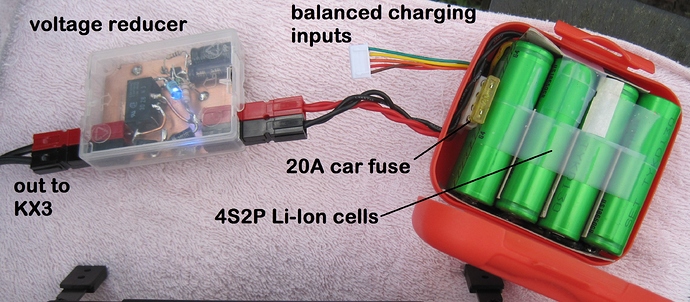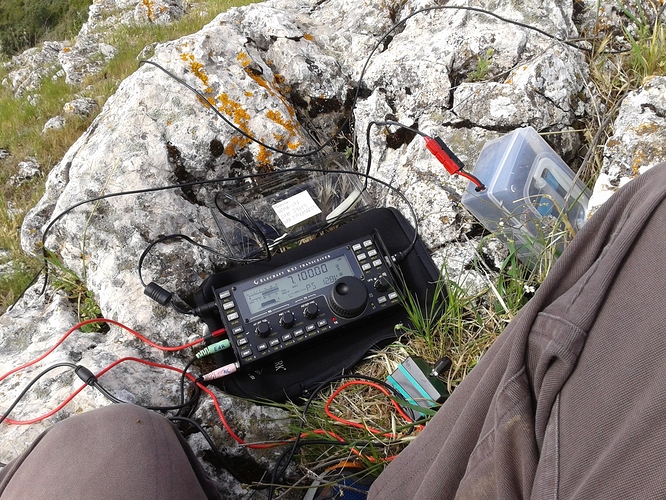Hello SOTA mates,
The homebrew device:
My friend Jorge, EA2LU, who is preparing his portable setup to do more SOTA activation, has receintly purchased a 4S cell 3 Amp LiPo battery (14,8 V nominal, 16,8V max charged) and we decided to do a joint activation to test it.
When the battery is charged to max voltage (16,8V) it is too high for the rated voltage in our portable transceivers. Most standard rigs have an acceptable deviation of 13,8 ±15%, that is max 15,9 volts.
Jorge prepared a voltage reducer composed of 3 diodes P600 connected in series with the battery. He added a bypass switch so that the diodes can be skipped once the voltage drops to a safe value.
Here you see a picture of his device with the sliding switch on top:
Batt testing results:
- Initial voltage: 16,8 Volts.
- Final voltage: 15,3 Volts (1,5 volts drop).
- Activation duration: 1h 35’ running the TRX at 10 watts out (current drain on TX: abt 1,9 Amp)
The diodes were all the time on to reduce the voltage to a safe value for the transceiver.
The reduction with diodes is 2,3 Volts, therefore the max voltage provided with diodes is 14,5 volt, which fits in the acceptance range.
- Conclusion: After 1h 35 minutes the diodes stayed connected and the voltage was still good (13 volts on the TRX). Therefore much longer activations could be carried out with this battery on summits.
Mt. Lakarri, driving directions:
- Exit Pamplona towards France (road N-135)
- Just after Larrasoaña turn right the exit towards Errea (road N-2337)
- Pass Setoain and keep straight until 42°53’23.6"N 1°30’21.5"W (42.889897, -1.505975) where a dirty road starts at right hand side.
- Park there and start the climb.
(GPS track is uploaded in the SOTA Mapping web page).
Climb:
- Trail is 3,4 kilometer long (one way)
- Heigh gain: 200m.
It is an easy trail that follows a wide dirty road for most part of it and in the last hundred meters it is a mountain path. Trail passes a thick pine tree and bleech forest thus making it recommendable for hot summer days.
When reaching the summit a small group of mountain goats were waiting for us, like saying hello from goat to goat:
Trig point at the summit facilitates fixation for the fish pole and antenna. The summit is well covered with box shrub. Jorge extended his EFHW wire as an inverted Vee configuration:
Activation:
- Date, Saturday 5th August 2017.
- EA2LU’s station: KX3 @10 watt. multiband EFHW with traps for auto band change.
- EA2BD’s station: FT-817 @5 watt. EFHW.
EA2BD’s aerial on the summit:
The summit is not large and soon bends into the forest. Therefore we couldn’t separate both antennas much. Mutual interference was strong.
I decided to activate briefly in 20m SSB only meanwhile Jorge did a longer run in CW, between 7 up to 28 MHz, to test his battery extensively.
Jorge’s CW keyer is comfortably held on the paper log table:
Incoming signals were not very strong and suffered from QSB, but we could log a lot of chasers, as usual on Saturdays.
We both enjoyed the day. It is a pleasure to have a walk on the countryside, test homebrew devices and share our hobby.
73 de Ignacio



